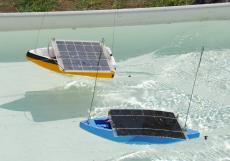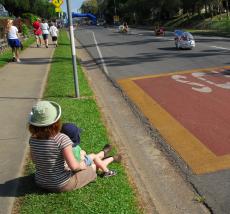Real racers…
 I spent last weekend at Maryborough in Queensland. So what was happening in this pretty town, a little inland from Fraser Island? The Holden-sponsored Maryborough Technology Challenge (MTC), that’s what!
I spent last weekend at Maryborough in Queensland. So what was happening in this pretty town, a little inland from Fraser Island? The Holden-sponsored Maryborough Technology Challenge (MTC), that’s what!
The MTC consists of technical competitions designed for school students, both primary and secondary. The challenges – that are really races – are fun and pedagogically worthy. Amongst other events, they consist of pushcart races, solar-powered boat races, robotics challenges, CO2-powered miniature drag racing and a human-powered vehicle race.
 I went along primarily to watch the human-powered race but found myself much enjoying the solar-powered boats. The boats race side by side in pairs, pushing their way through a long shallow pool. They are kept in line by wire guides following two stretched longitudinal fishing lines.
I went along primarily to watch the human-powered race but found myself much enjoying the solar-powered boats. The boats race side by side in pairs, pushing their way through a long shallow pool. They are kept in line by wire guides following two stretched longitudinal fishing lines.
The differences in boat performance were extraordinary – some boats just plugged along while others lifted their polystyrene noses and powered through the water, leaving a substantial wake. One student that I quizzed told me the electric motor driving his craft was Swiss-made – it was about as big as an AA cell yet gave the boat amazing performance. And of course, all the boats were directly powered by the solar cells mounted on them. As a way of integrating into the curriculum concepts of hydrodynamics, solar cell and motor efficiency, propeller pitch, renewable energy (and of course team-work and co-operation), I thought the boats were fantastic.
The CO2-powered drag racers also looked fascinating; however time constraints meant I could only see a few runs made. But hell, they were fast!
 But it was the human-powered vehicle race I got the most kick out of. Constructed by the schools involved (although, some schools had done all the construction themselves and others had farmed things out to external tradespeople – a bit of a cop-out), these vehicles consisted almost entirely of recumbent trikes. Some were running full aero-reducing fairings but most were bare. Construction quality and design varied from abysmal to fantastic.
But it was the human-powered vehicle race I got the most kick out of. Constructed by the schools involved (although, some schools had done all the construction themselves and others had farmed things out to external tradespeople – a bit of a cop-out), these vehicles consisted almost entirely of recumbent trikes. Some were running full aero-reducing fairings but most were bare. Construction quality and design varied from abysmal to fantastic.
The course, a street circuit with an added hairpin, was largely an endurance layout rather than having challenging corners. And endurance was certainly needed – for this was a 24 hour race. The school teams, complete with pit area tents and full support teams, ran a roster of riders but each machine had to go the full 24 hours. I watched them head off at 1pm, the students fired with enthusiasm and riding like their lives depended on it. Each time their entrant came past the pits a cheer erupted from the watching team members.
By dusk the pace had slowed a little, but the teams were still cheering, lap after lap. The headlights and tail-lights were on by now, and the first signs of mechanical failings were starting to occur. A chain not meshing smoothly, a drink bottle hose trailing behind a red-faced rider, one machine without its headlight working.
I went back to my motel, had a few drinks, checked the current race standings on-line, then went to bed. But as I went off to sleep, I thought of those riders still pedalling, those trike frames creaking and groaning each pass over the bumpy rail line, the young people finding the mental grit and determination and concentration to keep on racing, following the right cornering lines, keeping out of the way of the faster traffic, talking by two-way to the pits, monitoring their lap times – and doing it all with their thighs and calves on fire…
 At 9 o’clock the next morning I was back, having had a good sleep and a relaxing morning coffee. And there they still were, those racing machines, pushing their way around the track, the local SES emergency volunteers looking sleepy and bored, the dwindled spectators subdued and red-eyed.
At 9 o’clock the next morning I was back, having had a good sleep and a relaxing morning coffee. And there they still were, those racing machines, pushing their way around the track, the local SES emergency volunteers looking sleepy and bored, the dwindled spectators subdued and red-eyed.
And some of the machines were still going fast, stopping the big-screen radar display at 30 and 31 km/h. The front-wheel camber on a handful of machines had grown mightily overnight; some had developed a sinuous steering motion that would have been effective if it hadn’t been occurring on the straights; there were rattles and odd noises galore – and yet there were machines that still looked as tight and strong and sturdy and sweet as the hour their construction had been finished…
And there were crashes – I saw one very tired rider make the mistake of pulling on the right-hand brake caliper instead of the left and steer straight into a barrier – and the teams were talking about a roll-over. The steering on one machine went into radical shimmer as the tie rod fell off and some machines literally rattled their way around the whole course.
 I wasn’t there for the finish but the top six machines didn’t change much over the last 12 hours of the race.
I wasn’t there for the finish but the top six machines didn’t change much over the last 12 hours of the race.
I thought the weekend event quite fabulous – it’s great seeing people so focussed and committed, pitting themselves in most cases against the merciless clock, with real challenges involving physical and mental effort.

 Julian Edgar, 50, has been writing about car modification and automotive technology for nearly 25 years. He has owned cars with two, three, four, five, six and eight cylinders; single turbo, twin turbo, supercharged, diesel and hybrid electric drivelines. He lists his transport interests as turbocharging, aerodynamics, suspension design and human-powered vehicles.
Julian Edgar, 50, has been writing about car modification and automotive technology for nearly 25 years. He has owned cars with two, three, four, five, six and eight cylinders; single turbo, twin turbo, supercharged, diesel and hybrid electric drivelines. He lists his transport interests as turbocharging, aerodynamics, suspension design and human-powered vehicles.

on November 26th, 2008 at 2:32 pm
hey
I was a rider in the racv energy breakthourgh evert in maryborough, victoria, & it was sponsored this event 2! there are so-many catigories now, even for both primary & secondary school!
For more enquires go to http://www.racvenergybreakthrough.net